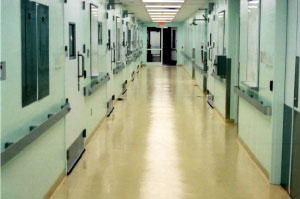Industry
Project Name: Modular Animal Care Facility, Flooring UWO
Location: London, Ontario
Owner: University of Western Ontario
Application: Over 30,000 square feet of high-performance trowelled epoxy flooring applied to the animal holding rooms, operating rooms, and hallways in the new Animal Care Facility.
Materials Used:
- Tnemec Series 237 Power-Tread
- Tnemec Series 280 Tneme-Glaze
- Tnemec Series 291 CRU
Environment Exposure:
- Frequent wash downs
- Agressive cleaning procedures
- Exposure to chemical attacks
Selection Process
High performance was a must when it came to selecting the right coating system for University of Western Ontario’s animal care facility. The architects of the project took note of Tnemec’s presence in the marketplace, and performance levels in other animal care facilities throughout North America when they specified the coating systems for the University’s new Modular Animal Care Facility. The architects also demanded that the products be installed flawlessly, and after detailed research, chose Applied Industrial Flooring as the certified Tnemec applicator specialist. Located in London, Ontario, UWO Modular Animal Care Facility is a two-level, 57,500 square foot holding and research facility which consists of four distinct modules to house mice, pigs, pregnant sheep, and primates. As well, the flexibility in the original design will allow for an additional three floors vertically as the need for expansion arises.
The Solution
“Tnemec was specified for 36,000 square feet of flooring and more than 100,000 square feet of drywall, CMU, and poured concrete wall surface,” explained Tnemec coating consultant, David Walker. Series 130 Envirofill, a cementitous acrylic masonry filler, was first applied to the CMU walls; Series 216 Quickfill, an aggregate-reinforced surfacer, was applied to the poured concrete areas; and the epoxy coating Series 27 F.C. Typoxy was spray-applied to the drywall.
The wall coating specifications consisted of a fiberglass-reinforced system for the holding rooms and the more high-risk animal-exposed areas, and a non-reinforced system for all interior overhead drywall and the remaining wall areas. Series 201 Epoxoprime, a modified polyamine epoxy, primed these high-risk wall surfaces. Series 273 Stranlok ML, a fiberglass mat-reinforced polyamine epoxy, was then roller-applied. One coat of Series 280 Tneme-Glaze, a protective polamine epoxy topcoat, sealed the Stranlok system, along with a coat of series 297 Enviro-Glaze, a waterborne polyurethane, to provide enhanced abrasion resistance and colour and gloss retention.
The interior overhead and less-exposed wall areas specified the non-reinforced coating system consisting of Epoxoprime as the primer, followed by two coats of Tneme-Glaze and a topcoat of Enviro-Glaze. All metal doors and window frames were coated with two to three coats of Series 66 Hi-Build Epoxoline, known for its benchmark performance, and Series 161 Tneme-Fascure, a low-temperature cure with a fast recoat at 75 degrees Fahrenheit.
Series 237 Power-Tread, a modified polyamine epoxy, was trowel-applied to the flooring at 1/4″ thickness, followed by a finish coat of Tneme-Glaze. The operating rooms also received a topcoat of Series 291 CRU for additional protection.,
THE RESULTS
The architectural firm as well, as the University of Western Ontario, recognized that it was very important to have the proper product and an approved applicator. In this type of facility, installation of the product and performance was critical. Applied Industrial Flooring took careful measures to ensure a flawless installation that would perform to the required standards.
The project management of the installation was also important and UWO found that Applied Flooring demonstrated solid professionalism in the delivery of the project and extraordinary expertise was shown amongst its applicators.


